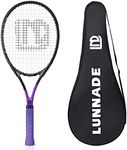Buying Guide for the Best Womens Tennis Rackets
Choosing the right tennis racket is crucial for enhancing your performance on the court and ensuring comfort during play. The right racket can help you improve your game, prevent injuries, and make playing more enjoyable. When selecting a tennis racket, consider your skill level, playing style, and physical attributes. It's important to find a balance between power, control, and comfort that suits your individual needs.WeightThe weight of a tennis racket affects how it feels in your hand and how it performs on the court. Heavier rackets (over 11 ounces) provide more power and stability, which can be beneficial for advanced players who can handle the extra weight. Lighter rackets (under 10 ounces) are easier to maneuver and are often preferred by beginners or players who prioritize speed and agility. If you're a beginner or have a smaller frame, a lighter racket might be more suitable, while more experienced players might opt for a heavier option for added power.
Head SizeHead size refers to the surface area of the racket's string bed and is measured in square inches. Larger head sizes (over 105 square inches) offer a bigger sweet spot, making it easier to hit the ball with power and forgiveness on off-center shots, which is ideal for beginners. Smaller head sizes (under 95 square inches) provide more control and precision, preferred by advanced players who can consistently hit the sweet spot. Intermediate players might choose a mid-sized head (95-105 square inches) for a balance of power and control.
BalanceBalance is the distribution of weight along the racket and is categorized as head-heavy, head-light, or evenly balanced. Head-heavy rackets provide more power and stability, making them suitable for baseline players who rely on powerful groundstrokes. Head-light rackets offer better maneuverability and are favored by net players who need quick reactions. Evenly balanced rackets provide a mix of both, which can be a good choice for all-court players. Consider your playing style when choosing the balance of your racket.
Grip SizeGrip size is the circumference of the racket handle and is crucial for comfort and control. A grip that's too small can cause the racket to twist in your hand, while a grip that's too large can lead to discomfort and strain. Grip sizes typically range from 4 inches to 4 3/4 inches. To find the right size, hold the racket and ensure there's enough space to fit your index finger between your fingers and palm. Choose a grip size that feels comfortable and secure in your hand.
String PatternThe string pattern refers to the number of main and cross strings in the racket's head. An open string pattern (fewer strings, like 16x19) allows for more spin and power but may wear out strings faster. A dense string pattern (more strings, like 18x20) offers more control and durability but less spin potential. If you like to hit with a lot of spin, an open pattern might be better, while players who prioritize control might prefer a dense pattern. Consider your playing style and how often you want to restring when choosing a string pattern.

















